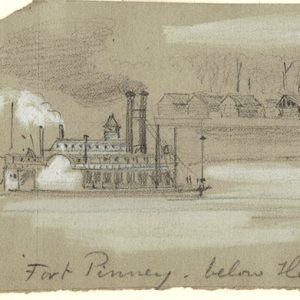calsfoundation@cals.org
Expedition from Fort Pinney to Kimball’s Plantation (January 27, 1865)
The expedition from Fort Pinney to Kimball’s Plantation was undertaken to break up a Mississippi smuggling operation.
Captain Benjamin Thomas of the Sixty-Third United States Colored Troops (USCT), who served as the District Superintendent of Freedmen for the Eastern District of Arkansas, organized the expedition, which was manned by troops from the Sixty-Ninth USCT under Captain Charles T. Parks from Fort Pinney, a contraband camp located southeast of Helena (Phillips County) across the Mississippi River from Friar’s Point (usually spelled Friars Point), Mississippi. The goal of the expedition was to capture a pair of deserters and smugglers, Private Harvey B. Dustin and Sergeant Duff G. Stewart who had deserted from Company E, Fifteenth Illinois Cavalry Regiment, on November 30, 1864.
Thomas worked with Acting Master William Ferguson of the seven-gun tinclad gunboat USS Silver Cloud to procure enough boats to carry around fifty soldiers on the raid. He found a Black man from Friar’s Point who could serve as a guide, disguising him in a Union uniform, and pressed an Irishman named Charles Phayer, who lived at Kimball’s house, to also show the Federal soldiers the way.
Ferguson landed the Silver Cloud at Fort Pinney and surreptitiously boarded the troops so that they were not observed from the Mississippi side of the river. They got into their assault boats at 2:00 a.m. on January 27 and paddled down the river to the eastern shore, where they split into two detachments led by Thomas and Parks. “At the early dawn we charged up to the house on the double-quick,” Thomas reported, with his men guarding the back of the house while Parks’s squad covered the front.
The two officers and six men entered the house, where they found Dustin’s clothing, leaving Thomas “well satisfied he was in or near the house,” despite Kimball’s insistence that he had not been there for a week. Finding Dustin’s pistol under Kimball’s pillow, Thomas ordered his troops to tear up the floor; they found Dustin “under the floor with his Henry rifle.” There apparently was an exchange of gunfire in which two soldiers were slightly wounded, and the Union officer instructed his men to set fire to the house in three places, leading the deserter to emerge unarmed, crying, “Oh, my God; oh, Captain Thomas, save me.”
A USCT soldier guarding Dustin told Thomas that he saw the prisoner hand Kimball “a small roll” as he passed her. Dustin confessed giving her $500 and said he gave Phayer $300 “to buy goods on the hill.” The Union officer concluded that Phayer and Kimball “were no doubt engaged with the deserters in the smuggling operation.” The Federals ended up seizing $817 in Union and Confederate currency along with “goods in a bag, handkerchiefs &c.; 1 Henry rifle and revolver of Dustin’s; [and] 1 worthless shotgun.”
The Union soldiers returned to the Silver Cloud, which brought them back to Fort Pinney, while Ferguson delivered Kimball to Federal authorities in Helena.
Though a relatively minor affair, the expedition from Fort Pinney to Kimball’s Plantation was apparently the only offensive operation involving the Sixty-Ninth United States Colored Troops.
For additional information:
The War of the Rebellion: A Compilation of the Official Records of the Union and Confederate Armies, Series I, Vol. 48, part 1, pp. 73–74. Washington DC: Government Printing Office, 1896.
The War of the Rebellion: A Compilation of the Official Records of the Union and Confederate Navies, Series I, Vol. 27, p. 55. Washington DC: Government Printing Office, 1917.
Mark K. Christ
Central Arkansas Library System
 Civil War Timeline
Civil War Timeline Military
Military Fort Pinney
Fort Pinney 



Comments
No comments on this entry yet.